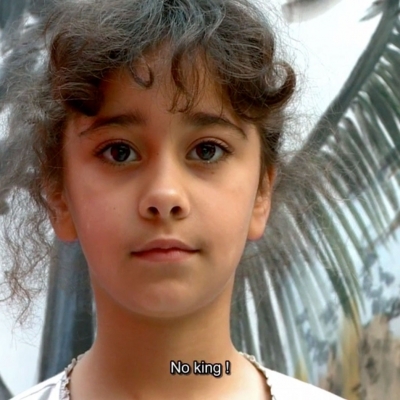Adelita Husni-Bey
Adelita Husni-Bey
The Reading / La Seduta, 2017
With Gus Moran, Nia Nottage, Farhan Islam, Nudrat Mahajabin, Katya Dokurova, Charlotte Lewis, Sandra Wazaz, Shao Lei, Amir Akram, Amanata Williams and Tina Zavitsanos
Adelita Husni-Bey’ s work addresses complex questions about race, class, and gender, often drawing inspiration from anarchist education theories and innovative teaching methods. Her projects are grounded in collective creative processes, such as role-playing, workshops, and group undertakings, which have involved students, athletes, lawyers, and activists. The task of an artist, in Husni-Bey’ s view, is to set up situations and experiments where the participants – and through them, the viewers – can come to terms with their own relationship to the social and economic power dynamics of our era.
Her piece for the Italian Pavilion, titled The Reading / La Seduta, was developed through a workshop held in Mannahatta (Lenape territory, known as Manhattan, New York) with a group of young people, selected via an open call circulated among a number of museum education departments around the city. This workshop, which took place in February 2017, included a series of meetings, discussions, and experimental theater exercises. Working with the artist and the other facilitators, the participants reflected on their own connections to the environment and to the exploitation of the earth, examining a series of complex questions related to ideas of extraction, threat, technology, use, value, and vulnerability. These themes appear in the video in the form of a tarot deck designed by the artist herself during the recent indigenous protests against the construction of a pipeline near the Standing Rock Reservation.
In the video, the participants, who are seated around a table, draw inspiration from a tarot reading performed with Husni-Bey’ s deck to talk about their own spiritual, colonial, and technological relationships to the earth and land. The artist uses the tarot reading as both a magical and a pedagogical tool: the young people – who in the video are seeing these cards for the first time – contrast an efficiency-based, capitalistic mindset, which views the earth as a source of profit to be mined, with a vision of it as something closely intertwined with human life, to be treasured and protected. The film cuts between the discussion around the table and scenes in which the participants perform a series of exercises inspired by themes adopted during the initial workshop, and based on the Theater of the Oppressed. Alongside the video, a series of sculptures – luminescent silicone hands – seems to suggest the advent of a virtual, prosthetic future, hinting at our own involvement in the consumption of resources and in new forms of colonization.
Biography
Born 1985, Milan. Based in New York.
Husni-Bey’ s After the Finish Line, was recently acquired by the Whitney Museum in New York. The artist received a Graham Foundation grant for 2016 and is currently working with the Serpentine Gallery, London, on the project Dependence, Independence, Isolation, to be developed further in 2017.
Her most recent solo exhibitions include A Wave in the Well, Sursock Museum, Beirut, 2016; The Classroom, curated by Paola Nicolin, Milan, 2016; Movement Break, Kadist Foundation, San Francisco, 2015; Playing Truant, Gasworks, London, 2012.
She has taken part in group shows, including The Eighth Climate, 11th Gwangju Biennale, 2016; Ennesima, curated by Vincenzo de Bellis, Triennale di Milano, Italy, 2015; Really Useful Knowledge, Museo Reina Sofía, Madrid, 2014; Utopia for Sale?, curated by Hou Hanru, MAXXI, Rome, 2014.






























